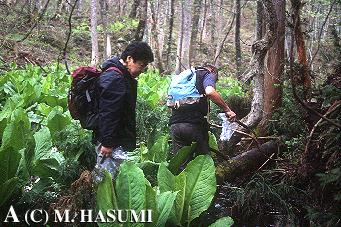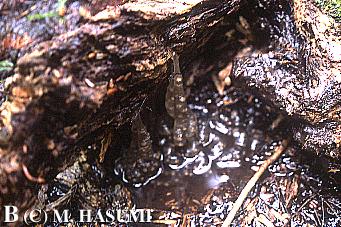

 |
 |
(A) Part of the swamp, dominated by growing Lysichiton camtschatcense (photographed on 15 May 2005). You can see two persons, M. Kakegawa (left) and F. Kishi (right), searching for salamander individuals and egg sacs.
(B) A decaying log in the swamp (water temperature = 10.2 C, water pH = 7.0), the underside space of which had 7 pairs of egg sacs of the salamander Hynobius hidamontanus, including embryos between the blastopore stage and the neural-fold stage (photographed keeping the underside of the log lateral).
At the time of examination, the adhesive tips of 3 other pairs of egg sacs of H. hidamontanus, including embryos between the blastula stage and the blastopore stage, were attached to a tiny twig in the swamp. In these pairs of egg sacs, 24 and 27 eggs, 25 and 32 eggs, and 26 and 31 eggs were counted because of their seemingly larger number of eggs than usual. Further, 1 pair of egg sacs and 1 juvenile were found under a decaying log in a brook adjacent to the swamp and under a decaying log above ground on land at a distance of approximately 50 m from the swamp (dispersal?), respectively. Each of two decaying logs above ground on land near the edge of the swamp harbored 1 male of the salamander Onychodactylus japonicus and 1 male of the frog Rana tagoi.
Accompanied Research Collaborators (in alphabetical order every organization): Masaichi Kakegawa (Tokyo Metropolitan Komatsugawa Senior High School); and Fujio Kishi and Yuko Saikawa (Shirouma Association of Naturalists).